Chiang Kai-Shek Memorial Hall features a museum on its ground floor with exhibits on the former Taiwanese president's life, including his military uniforms and cars. A gigantic bronze sculpture of Chiang sits at the top of 89 steps, flanked by motionless guards. The hall is also known for its strict dress code, stating that those wearing slippers or slovenly clothing will not be admitted.
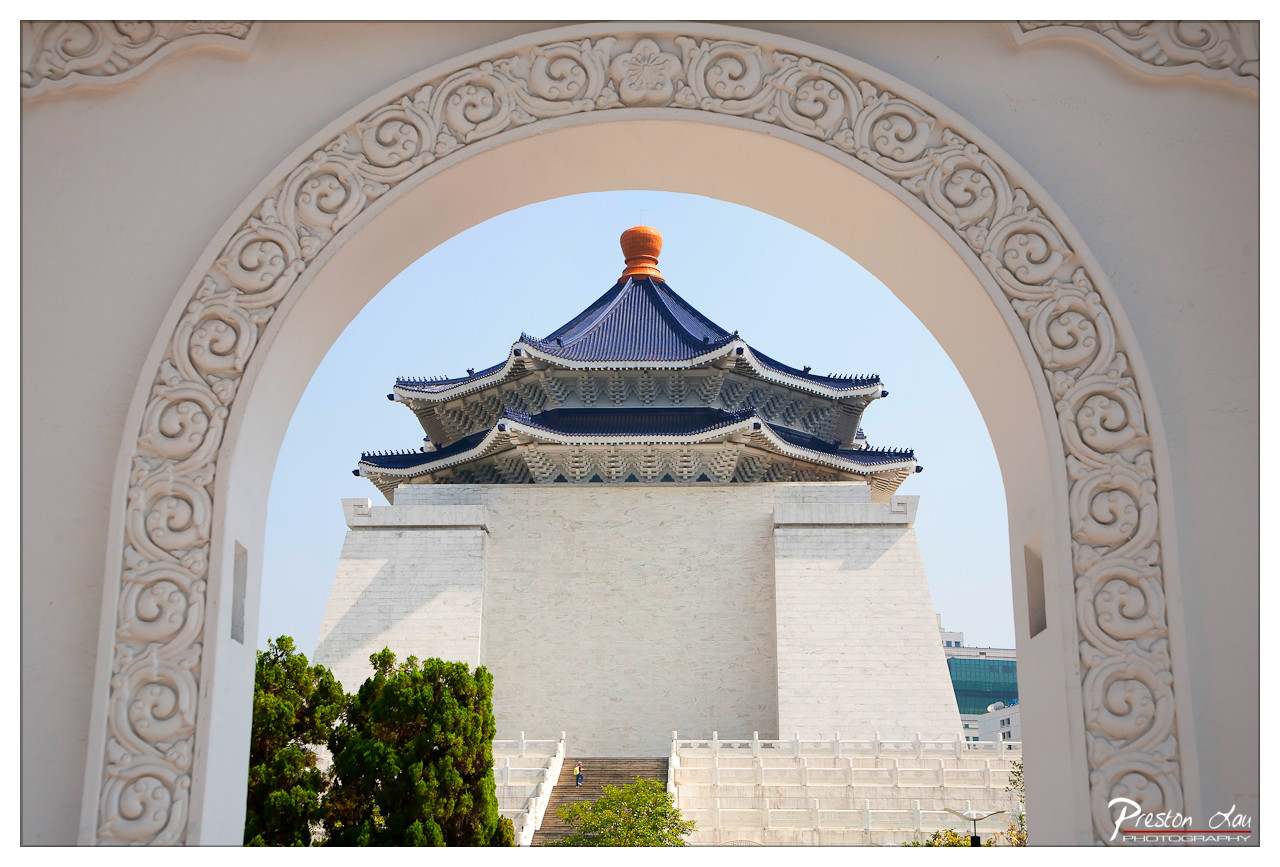

A Grand Entrance to Grandeur
Rating: 9/10
This photograph offers a majestic view of the Chiang Kai-shek Memorial Hall, a striking monument in Taipei, Taiwan, famed for its brilliant blue tiled roof and pristine white walls, capped with a vibrant orange finial. The scene is framed by a magnificent white archway adorned with intricate carvings, acting as a sophisticated window into the subject. The bright, clear blue sky provides a clean backdrop, making the structure stand out vividly under what appears to be generous midday sun. A single, tiny figure is visible climbing the numerous wide steps leading up to the hall, serving as a crucial element that emphasizes the monumental scale of the architecture. Green trees punctuate the lower left, adding a touch of organic contrast to the structured environment.
From a photographic perspective, this is a masterclass in framing. The ornate archway doesn't just sit there; it actively participates in the composition, drawing the eye inward and adding a layer of depth and aesthetic appeal that a straight-on shot might lack. The photographer has expertly positioned the subject dead center within the arch, creating a strong sense of symmetry and balance. The lighting is excellent, flat yet bright enough to reveal the intricate details on both the arch and the building's multi-tiered roof structure without harsh shadows. The inclusion of the solitary person on the stairs is a brilliant touch – perhaps they are just popping in to ask for directions, or maybe they are about to embark on the climb of a lifetime, adding a hint of narrative and highlighting the sheer effort required to reach the entrance of this architectural giant. It’s a well-executed shot that captures the grandeur and scale effectively.
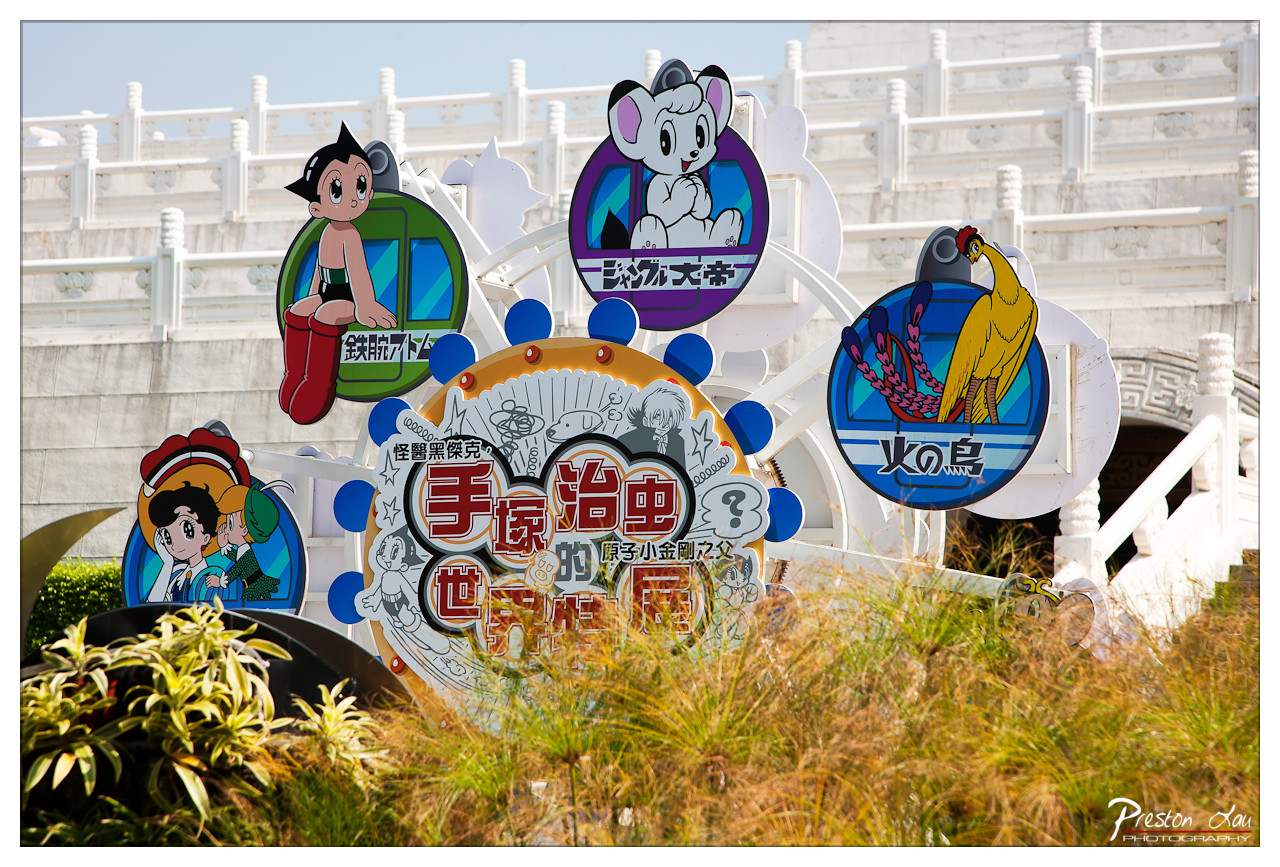

Tezuka's Greatest Hits: Architectural Encore
Subject Rating: 7/10
Well, look what we have here – a full-blown manga party crashed by a very serious-looking building! This photo captures a delightful, albeit slightly awkward, collision of worlds. We see a vibrant display celebrating the iconic characters of Osamu Tezuka, the "God of Manga." Astro Boy looks ready to rocket off his perch, Kimba the White Lion is looking rather pleased with himself, and the majestic Phoenix is spreading its wings, all mounted on what appears to be a Ferris wheel structure or a circular sign setup. The central panel is a chaotic but charming montage of Tezuka's universe, proclaiming something significant in Japanese text, undoubtedly related to an exhibition or event dedicated to his genius. This whimsical structure is plonked right in front of a grand, imposing white building with massive staircases and ornate railings – a structure that screams importance and history, perhaps a museum or a significant memorial. The contrast between the playful, colorful characters and the stoic, monumental architecture is the heart of this image.
From a photographic perspective, this is a decent capture that tells a story, even if slightly imperfect. The composition places the playful display front and center, immediately grabbing attention. However, the photographer opted for a low angle, which, while making the display feel grand, also introduces a significant amount of foreground foliage that obstructs the bottom of the main structure. This fuzzy green and brown layer is a bit of a visual speed bump, though it does add a layer of depth. The bright daylight provides good illumination, ensuring the characters and the building details are clearly visible, although the direct light might flatten the scene slightly, particularly on the white building. The color palette is a study in contrasts: the vivid, saturated hues of the manga characters pop dramatically against the neutral white and grey tones of the background building. It highlights the intended visual impact of the installation itself – a splash of vibrant pop culture against a backdrop of traditional grandeur. Overall, it's a fun subject captured with reasonable technical skill, though perhaps a slight adjustment in perspective could have lifted it from good to great by clearing the foreground obstruction.
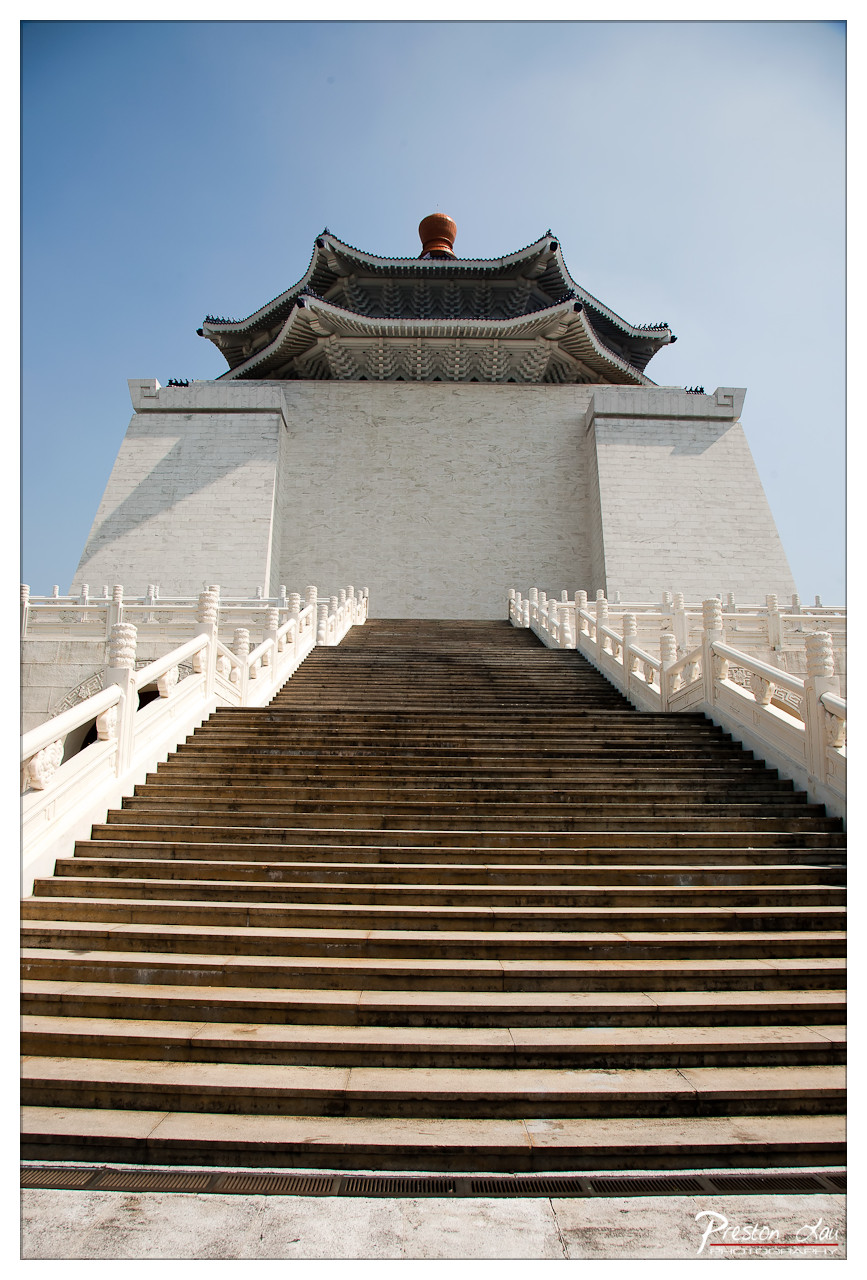

The Stairway to Epic Glute Gains
Rating: 8/10
Standing at the bottom of this monumental staircase, the Chiang Kai-shek Memorial Hall in Taipei asserts its grandeur and, frankly, makes your leg muscles contemplate mutiny. The scene is one of pure, unadulterated scale and architectural might, lending the image a mood that's both awe-inspiring and slightly daunting. It’s the visual equivalent of looking up at a mountain you know you have to climb, except this mountain is made of exquisitely crafted marble and looks decidedly less natural. The sheer number of steps is the primary focus, drawing the eye relentlessly upwards towards the impressive structure that dominates the upper half of the frame.
From a photographic standpoint, this is a classic low-angle power shot. The composition effectively uses the leading lines of the stairs and ornate white railings to guide the viewer's gaze directly towards the main subject. The low perspective exaggerates the height and scale of the building, a simple but effective trick for conveying monumentality. Lighting is typical bright, midday sun, which creates strong, dramatic shadows on the stairs, adding texture and depth, though it can sometimes be less flattering on the flat white walls. The limited color palette of white, stone grey/brown, and the clear blue sky keeps the focus sharp on the architectural forms, while the traditional Chinese roof details provide a splash of contrasting color and intricate design against the vast white volume of the base. It's a strong, symmetrical composition that serves the subject well for a travel or architectural portfolio.
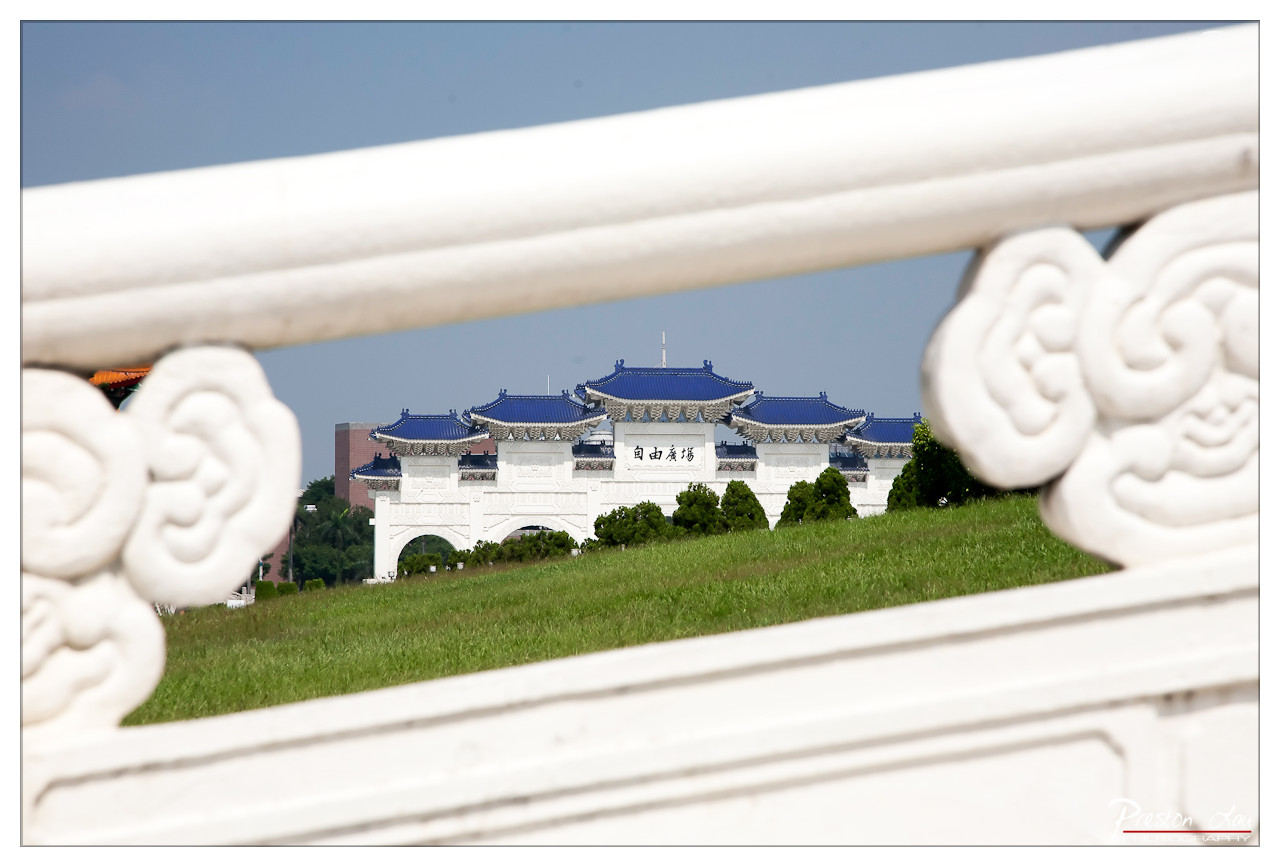

The Gate and Its Assertive Balustrade
Rating: 6.5/10
This photograph presents a view of the impressive main gate at Taipei's Freedom Square, an iconic landmark with its multiple white arches and striking blue roofs. The gate itself, adorned with intricate detailing and the bold inscription "自由廣場", stands proudly on a grassy hill beneath a clear blue sky, flanked by trees. The bright daylight illuminates the scene, bringing out the vibrant blue and crisp white of the architecture against the lush green of the landscape. It’s a grand subject, conveying a sense of formality and cultural significance, captured on a bright, pleasant day.
From a photographer's standpoint, the most prominent feature is the deliberate framing by the white, decorative balustrade in the foreground. This technique adds depth and context, creating a window-like effect to view the gate. However, it also takes up a significant portion of the frame, perhaps slightly overpowering the main subject. The bokeh on the balustrade is smooth, softening the foreground elements, but its sheer size makes it a very assertive 'gatekeeper' to the view. It's a bold compositional choice that adds interest but might leave the viewer wishing for a clearer, less obstructed look at the magnificent gate itself – a classic case of foreground distraction vs. effective framing.
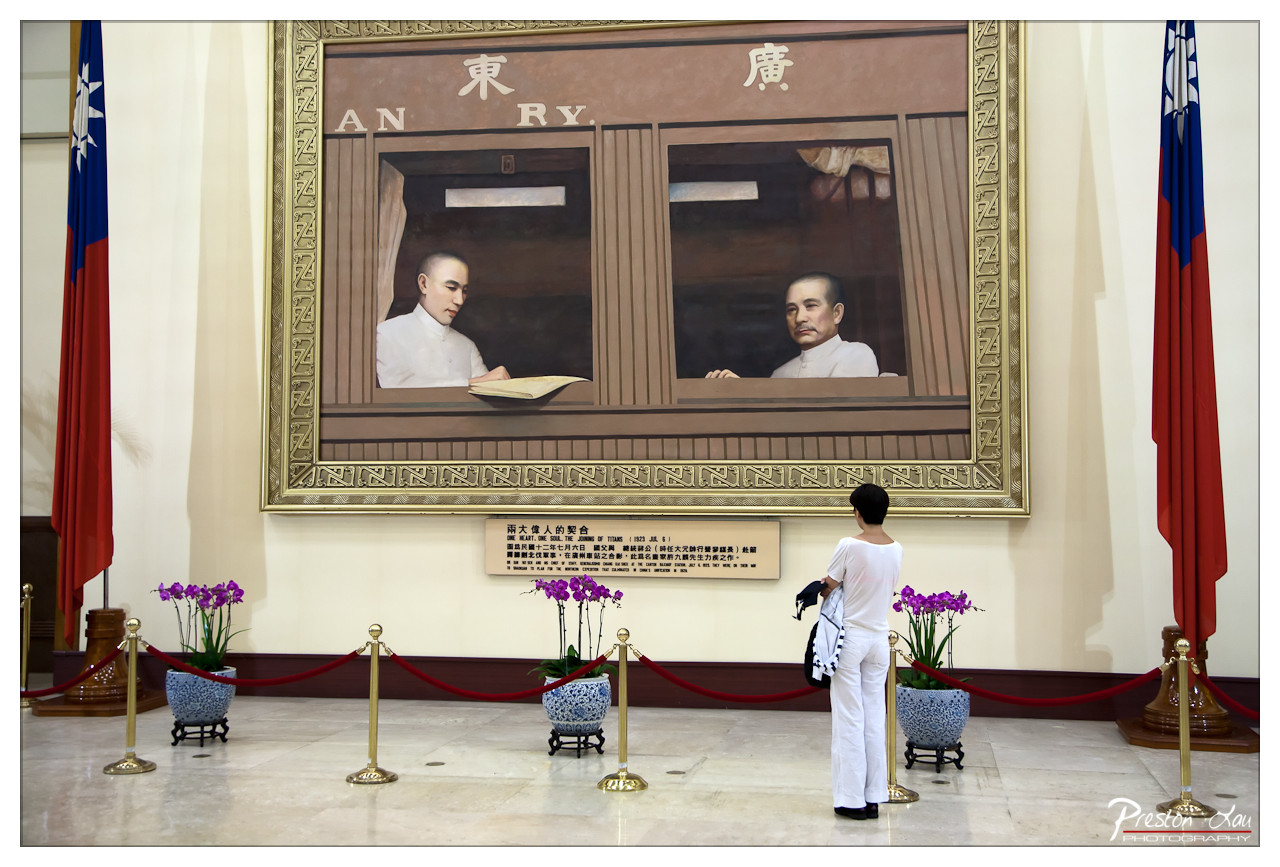

The Titans and the Tourist
Subject: 9/10
In what appears to be a grand, historically significant hall, a large painting dominates the central space, flanked by two prominent flags of the Republic of China. The painting itself is a fascinating vignette, depicting two distinguished men seated within what looks like a train compartment, engrossed in reading or contemplation. Above them, text in English and Chinese hints at the location or context, while below, Chinese characters accompanied by the English phrase "THE JOINT OF TITANS (1923. JUL. 6)" firmly place this scene in a pivotal historical moment, likely featuring key figures of modern Chinese history like Sun Yat-sen and Chiang Kai-shek during an important meeting. A lone visitor, dressed in white, stands before the painting, seemingly lost in thought or observation, bridging the gap between the epic scale of the depicted past and the quiet present moment of viewing. In the foreground, elegant red velvet ropes on brass stands create a barrier, suggesting the importance and perhaps fragility of the display, while potted purple orchids add a touch of vibrant, contrasting color against the rich, warm tones of the painting and hall.
From a photographic perspective, the composition is strong, utilizing the symmetrical grandeur of the flags and the central painting, grounded by the horizontal lines of the barriers and the anchors of the potted plants. The photographer has captured the immense scale of the painting and the space effectively, using a slightly elevated perspective that includes the polished floor reflecting the light. The lighting is even and functional, perfectly illuminating the artwork and the scene, though perhaps lacking dramatic flair – suitable for a museum setting where the art should shine. The color palette, though dominated by the warm browns and reds of the painting, flags, and ropes, gets a delightful jolt from the vivid purple orchids, adding a touch of unexpected beauty. While the historical subjects in the painting look intensely focused, the lone visitor provides a relatable human element, perhaps contemplating the weight of history or simply admiring the brushstrokes. The challenge here is capturing the atmosphere of a public space while minimizing distractions, and the photographer has largely succeeded, positioning the viewer to draw the eye to the main subject while incorporating the environmental context like the barriers and floor. It's a straightforward, clean shot that tells a story of historical legacy and present-day engagement.
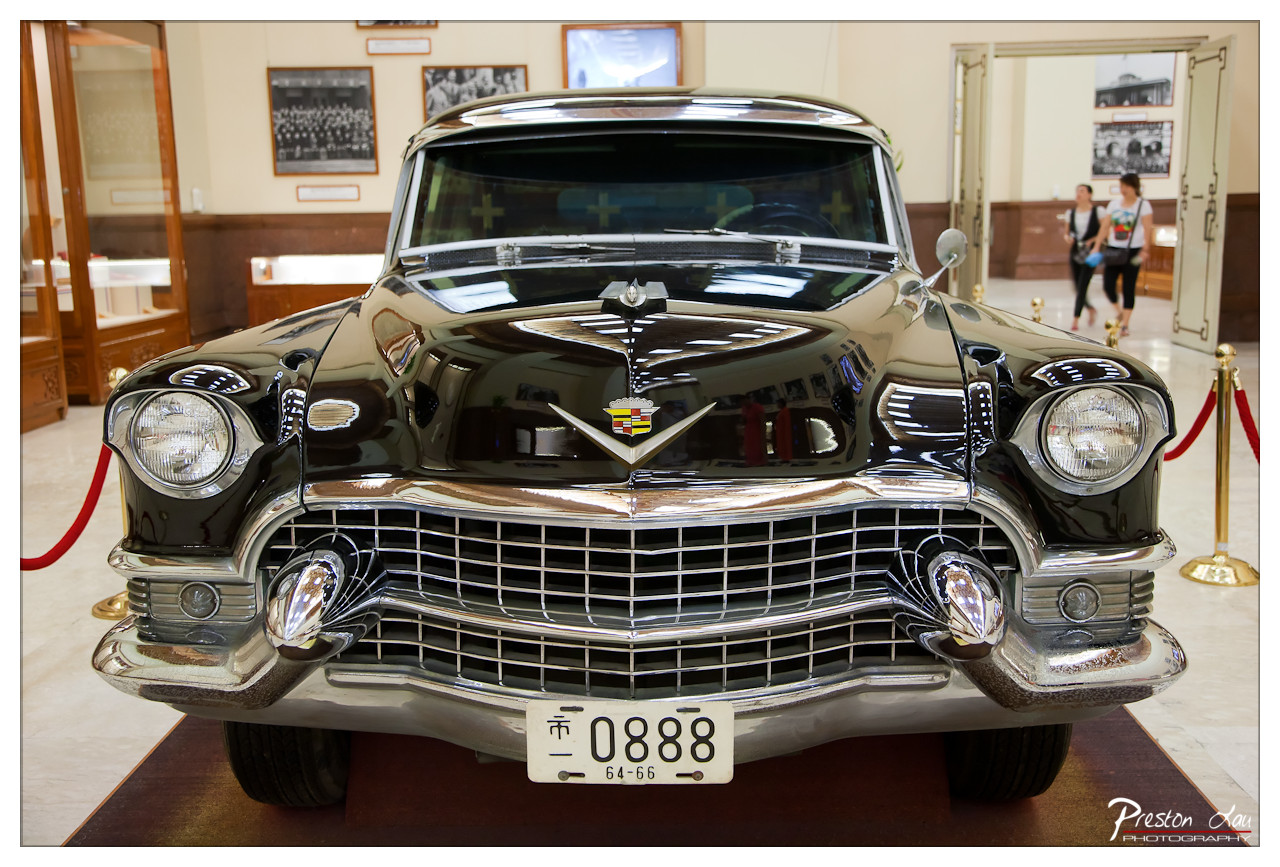

Cadillac Grandeur on Display
Subject: Classic Black Cadillac Limousine (9/10) - Because who doesn't love a boat-sized, chrome-laden symbol of mid-century American luxury? It's an absolute stunner, even sitting still. This gleaming black beauty is the undisputed star, commanding attention with its imposing grille and polished surfaces, looking every bit the dignified relic of a bygone era of excess.
What's happening here is essentially a portrait session for a very important vintage automobile, likely displayed in a museum or historical collection. It's roped off, as all great celebrities should be, preventing sticky fingers from admiring its flawless finish too closely. In the background, the mundane reality of a museum visit unfolds with blurred figures milling about, providing a subtle contrast between the static grandeur of the car and the transient flow of visitors. The mood is one of historical significance and quiet admiration, punctuated by the sheer visual weight of the subject.
From a photographic standpoint, the composition is bold and symmetrical, placing the car dead center, almost challenging the viewer to take in its full frontal glory. This head-on angle emphasizes the iconic grille, headlights, and the shiny chrome bumper that looks ready to fend off lesser vehicles (or maybe just museum ropes). The lighting, which seems to be ambient from the room, plays beautifully on the car's highly reflective black paint and chrome accents, creating dazzling highlights and deep shadows that sculpt the form. However, those reflections, while showcasing the mirror-like finish, also act as unwitting mirrors for the ceiling, lights, and anything else above, adding visual complexity that some might find distracting – a classic challenge when shooting polished surfaces. The color palette is dominated by the strong contrast between the car's dark exterior and bright chrome against the warmer, softer tones of the wooden display cases and background walls. The depth of field is relatively shallow, keeping the background soft and ensuring the focus remains firmly on the automotive star, even with the interesting details like framed photos and distant people peeking through doorways. The license plate, "0888 64-66", adds a specific detail, rooting the car in a particular era. It's a clean shot, capturing the essence of this classic Cadillac with a respectful, almost reverent, stance.
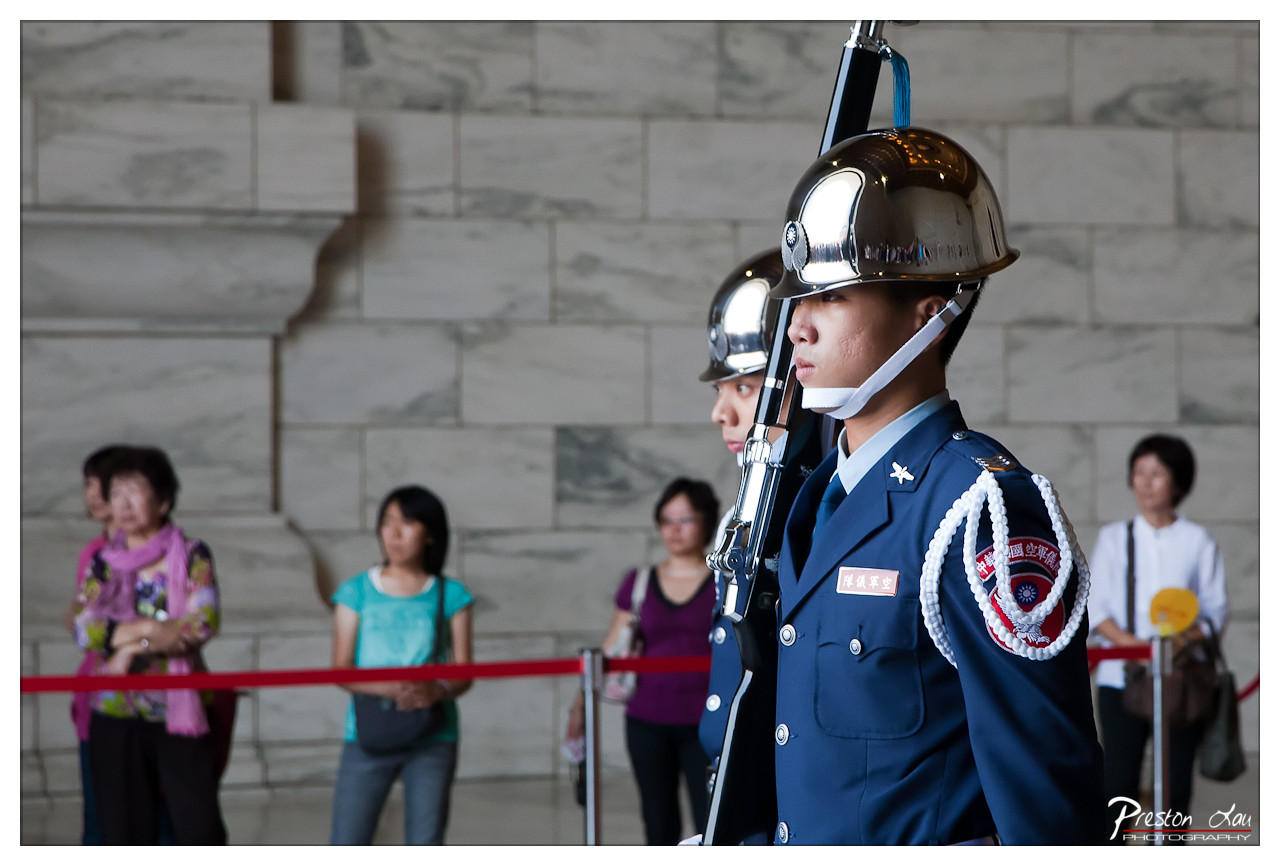

Silent Sentinels and Sideline Spectators
Subject Rating: 8/10
Here we have a classic shot of duty-bound precision meeting tourist curiosity. The frame is dominated by two guards in immaculate blue uniforms and dazzling chrome helmets, standing rigidly at attention with their rifles. The focus is sharp on the lead guard's face and the intricate details of his uniform, including the crisp white chinstrap, the star insignia, and the elaborate white rope accoutrements. Behind him, the second guard is partially visible, adding a sense of depth and formation. These chaps clearly weren't told to "smile for the camera." In the background, blurred into soft shapes, are several onlookers – a woman in a vibrant floral scarf, another in a turquoise top, and a third in white – held back by a red barrier. They provide a human counterpoint to the guards' static formality, seemingly engaged in witnessing the ceremonial stillness. The setting appears to be inside a grand building with large, patterned marble blocks forming the wall behind them.
From a photographic perspective, this image uses a shallow depth of field effectively to isolate the main subjects from the busy background. The composition is tight, perhaps a little *too* tight on the left, almost cropping the first guard's elbow, but it successfully draws the eye to the sharp lines and reflective surfaces of the guards and their gear. Lighting seems to be natural ambient light, creating soft shadows and brilliant highlights on the highly polished helmets – excellent for catching the viewer's attention, though perhaps a challenge to meter correctly without blowing out those highlights entirely. The contrast between the formal, structured subjects and the relaxed, blurred figures behind the barrier is visually interesting and tells a story about the scene. It captures the essence of observation – the tourists observing the guards, and the photographer observing the scene unfolding. A slightly wider shot might have offered more context of the building, but this tight crop excels at emphasizing the imposing presence of the guards themselves.
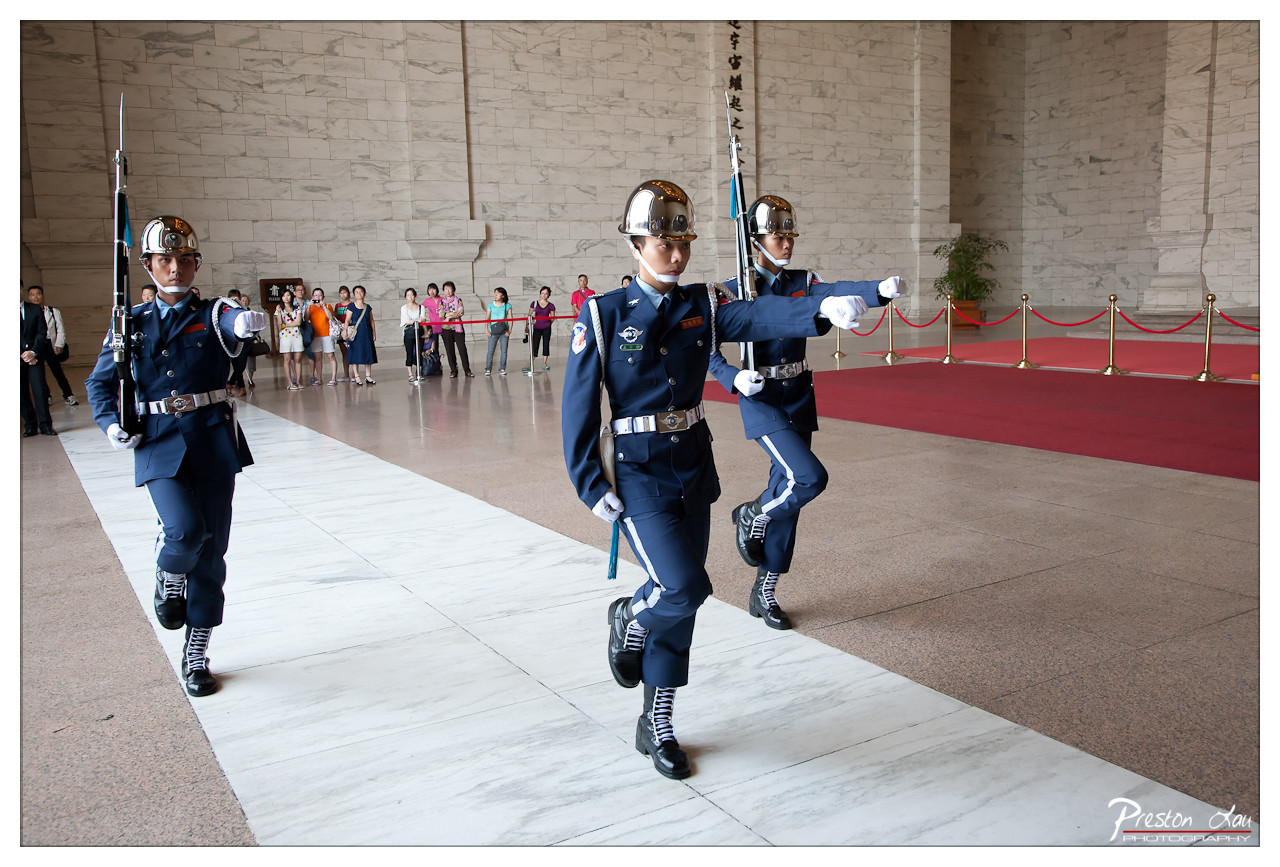

Guardians of the Marble Hall March
Subject: 8/10
Here we have the stern-faced guardians, marching with the precision of a highly calibrated robot army through what appears to be a rather grand marble hall. Our subjects, rated a solid 8/10 for their impressive discipline and dazzling headgear, are mid-ceremony, likely performing a changing of the guard ritual that demands perfectly synchronized high kicks and unflinching stares. Dressed in sharp navy blue uniforms, complete with white gloves, gleaming belts, and highly reflective helmets that probably double as signal mirrors, they clutch their equally polished rifles. The mood is one of solemn duty, offset slightly by the gaggle of tourists in the background, cameras poised, clearly wondering if they can get a selfie with the stoic chaps without getting jabbed by a bayonet.
From a photography standpoint, the composition does a decent job of leading the eye with the diagonal line of the guards, though the guy in the front left is a bit close, cutting off his feet slightly. The lighting is natural but a touch flat, making the texture of the marble walls the star alongside the guards' shiny bits. The deep blue of the uniforms pops against the cool, neutral tones of the hall and the warm red of the carpeted area in the distance, creating a pleasing, if slightly expected, color palette for a formal setting. Capturing moving subjects like this requires good timing, and the photographer managed to freeze the action mid-step, highlighting the effort and style of their march. It's a classic capture of a popular ceremonial event, demonstrating the challenge of balancing a busy background with the main, dynamic subject. One could argue a lower angle might have emphasized their powerful stride more, but then you'd probably get a lot of floor.
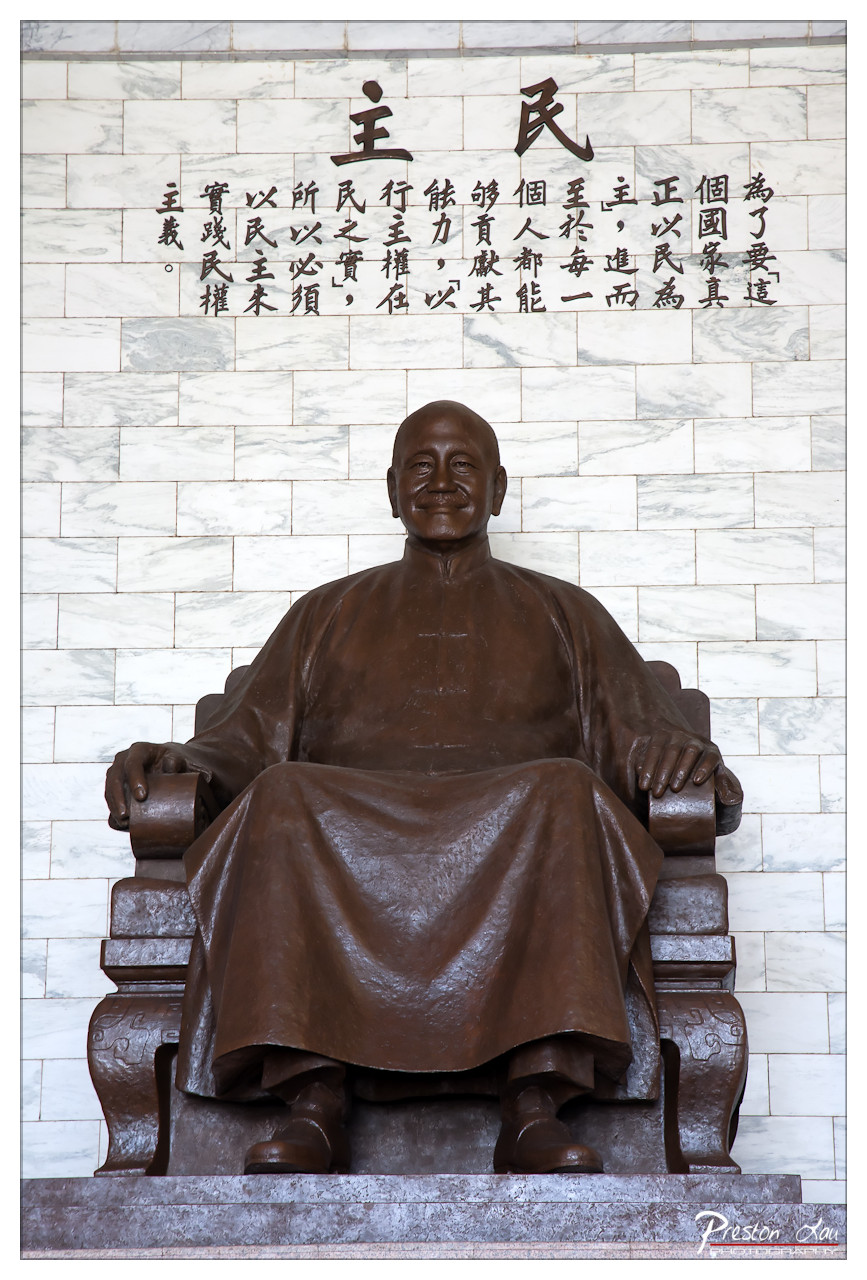

Title: The Eternal Seat and the Weighty Words
Rating: 7/10
This striking image presents a large, seated bronze statue of a man, identifiable as Chiang Kai-shek, resting comfortably on a substantial, throne-like chair. He is depicted wearing traditional clothing and offers a subtle, perhaps slightly amused, smile to the viewer. Behind him stands a grand wall constructed from blocks of white marble, its subtle veining providing a textural backdrop. Prominently displayed above his head are large, dark Chinese characters carved into the wall, adding an important layer of context and authority to the scene. The atmosphere is undeniably formal and historical, conveying the gravitas associated with such a figure and setting, yet the unexpected hint of a smile on the statue introduces a curious note of accessibility or even warmth to the monumental subject.
From a photographer's viewpoint, the composition is symmetrical and centered, placing the subject squarely as the focal point and emphasizing his significance. The low angle shot further enhances the sense of scale and power, making the statue loom large. The lighting appears to be even and soft, possibly diffused ambient light, which does a commendable job of illuminating the entire statue and the text clearly, avoiding harsh shadows. This makes the details of the bronze work and the carving easily visible, crucial for a documentary or architectural shot like this. However, the flatness of the light prevents much dramatic sculpting of the statue's form. The color palette is appropriately restrained, focusing on the contrast between the rich brown of the bronze and the cool, clean tones of the marble. While effective for clarity and presentation, one might consider if a slightly more directional light could have added depth, although keeping those significant characters above perfectly readable was clearly a priority. And honestly, that chair looks deceptively comfortable for an eternal sitter.
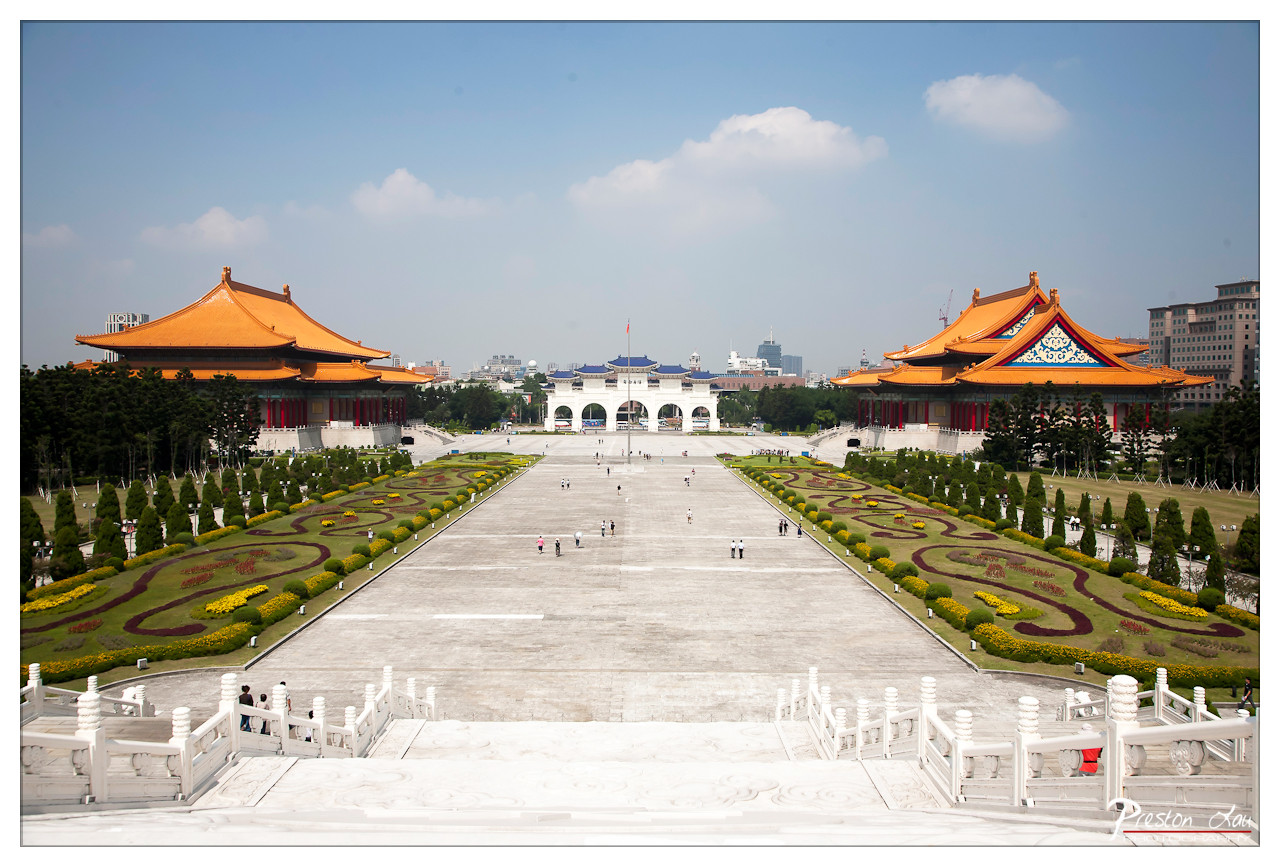

The Grand Stage of Taipei
Rating: 8/10
Welcome to the vast expanse that is the Chiang Kai-shek Memorial Hall area in Taipei! This image captures the impressive scale and symmetry of this iconic landmark, showcasing the National Concert Hall on the left, the National Theater on the right (both rocking those fabulous orange roofs), and the stately Freedom Gate leading the eye back towards the main Memorial Hall itself. On this bright, clear day, the mood is one of peaceful grandeur, despite the handful of tiny humans milling about the gargantuan plaza below – seriously, is that plaza big enough, or do they need more room for synchronized tai chi? The perfectly manicured gardens add a touch of colorful flourish, guiding your gaze like architectural breadcrumbs across the scene from the elevated vantage point, reminding you that even concrete landscapes need a little floral flair.
From a photography standpoint, capturing the sheer scale of this place is always a challenge, and this shot gives it a solid go from the top of the many, many steps (not visible in their entirety, thankfully for our knees). The composition leans heavily into the powerful symmetry, using the buildings and the plaza's geometry to create a balanced, if perhaps slightly textbook, view. The bright, sunny lighting brings out the vibrant colors of the roofs and gardens, though the intensity of the sun does mean some highlights on the white marble steps are pushed to the limit – nothing a good pair of shades and some exposure compensation can't handle. It's a classic wide shot, capturing the essence of the location, making you feel both small in the face of history and architecture, and maybe a little thirsty from the glare reflecting off all that white stone.
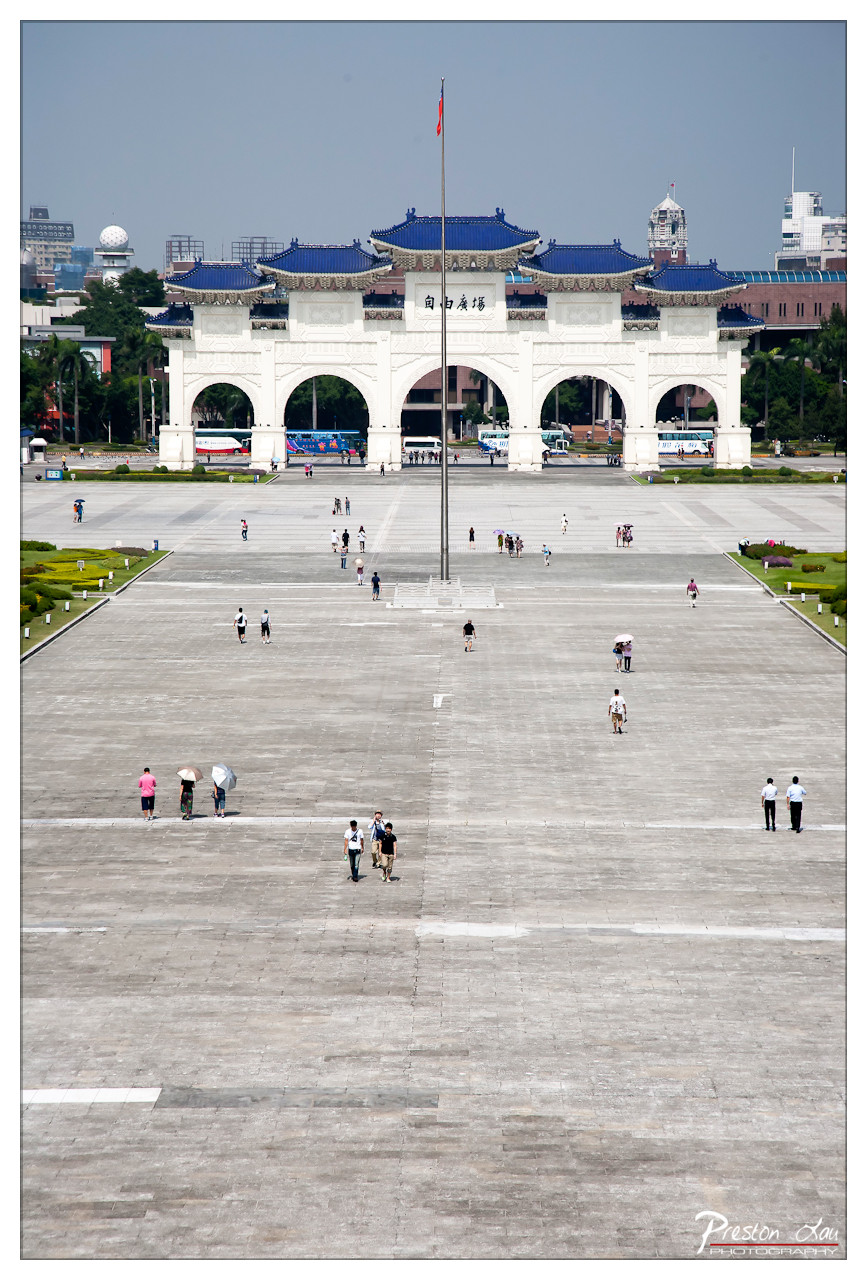

The Grand March Across Liberty Square
Rating: 7/10
"The Grand March Across Liberty Square" - Rating: 7/10. This image offers a high-angle view of the impressive Pailou, or main gate, marking the entrance to Liberty Square in Taipei. The vast, paved expanse of the square dominates the foreground, dotted with individuals and small groups of people making the long trek across it. The atmosphere is one of quiet scale and openness, highlighting the monumental nature of the site, where human figures appear relatively insignificant against the sheer size of the space.
From a photography perspective, the composition employs strong symmetry, centering the grand gate and placing the flagpole directly in front, which, while reinforcing the formality of the scene, also somewhat obstructs the view of the gate itself. The high perspective effectively conveys the immense depth and width of the square, leading the eye towards the architecture. The lighting is bright and possibly harsh mid-day sun, resulting in relatively flat colors and a slightly washed-out feel, though the deep blue of the roof tiles still provides a nice contrast to the predominantly grey and white tones. The subject matter is the interaction of people with a large public space and significant architecture. The background reveals glimpses of Taipei's cityscape and surrounding trees, placing the historical site within its modern context. It's a competent shot documenting the location's scale, but one can't help but wonder if the journey across the square is as epic as the view suggests, or just really, really long.
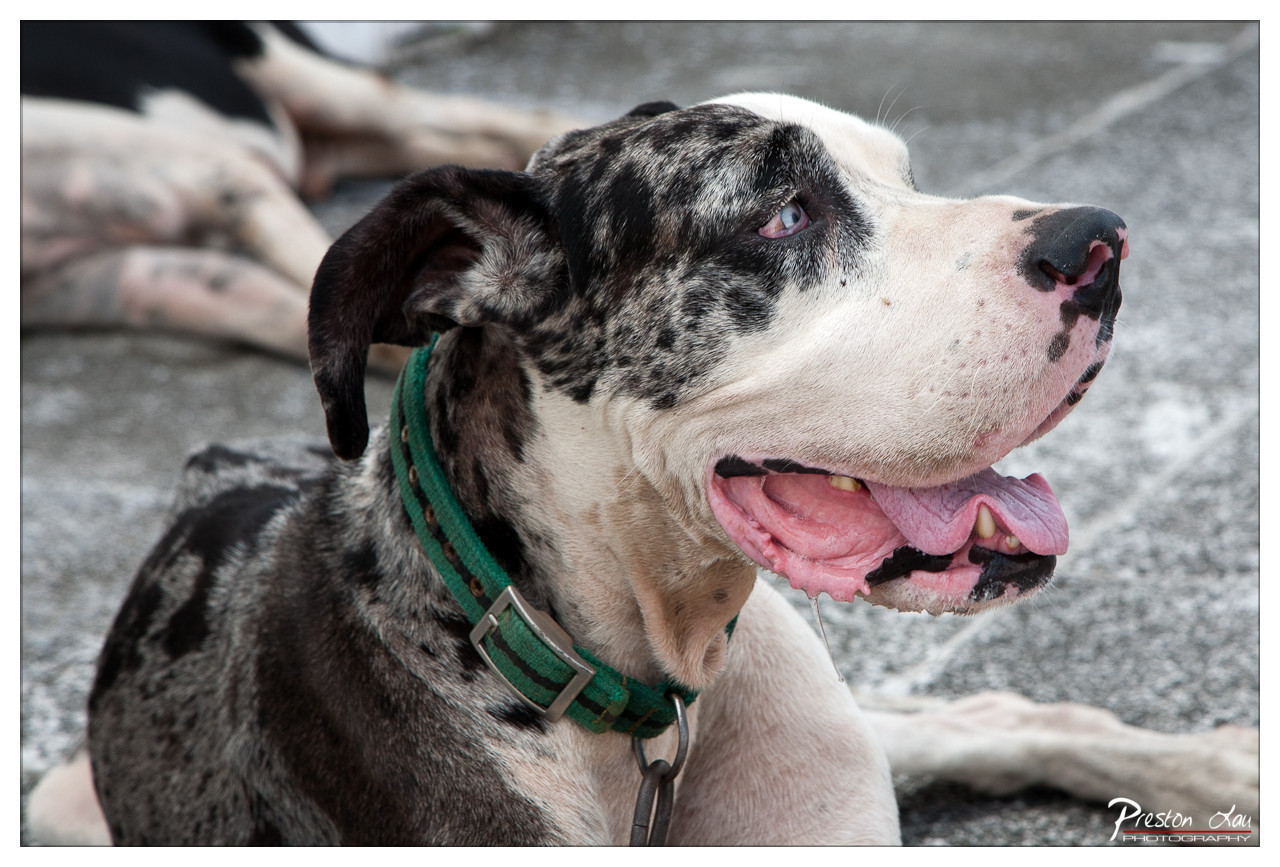

The subject, a magnificent Harlequin Great Dane, earns a solid 9/10 for sheer presence and unique coat pattern. This gentle giant is captured mid-pant, tongue lolling out in a pink cascade, perhaps contemplating the existential burden of being so large, or maybe just wondering where the next snack is coming from. The mood is one of relaxed exhaustion or warm-weather effort, underscored by the slight drool making a bid for freedom from the dog's jowls. Wearing a practical green collar that contrasts nicely with his monochrome fur, he's clearly taking a break, with another large, blurry canine companion lounging anonymously in the background.
From a photography perspective, the composition is a thoughtful close-up profile, expertly utilizing a shallow depth of field to draw the viewer's eye directly to the subject's expressive face, particularly those striking blue eyes. The lighting is soft and natural, highlighting the textured fur and moistness of the tongue without harsh shadows – ideal for capturing the dog's features. The limited color palette of black, white, grey, and the vibrant pink and green keeps the focus tight. The blurred background effectively removes distraction, placing this majestic creature squarely in the spotlight, showcasing his noble if slightly overheated, profile. It's a great capture of a beautiful animal in a very relatable state of dog-tiredness.
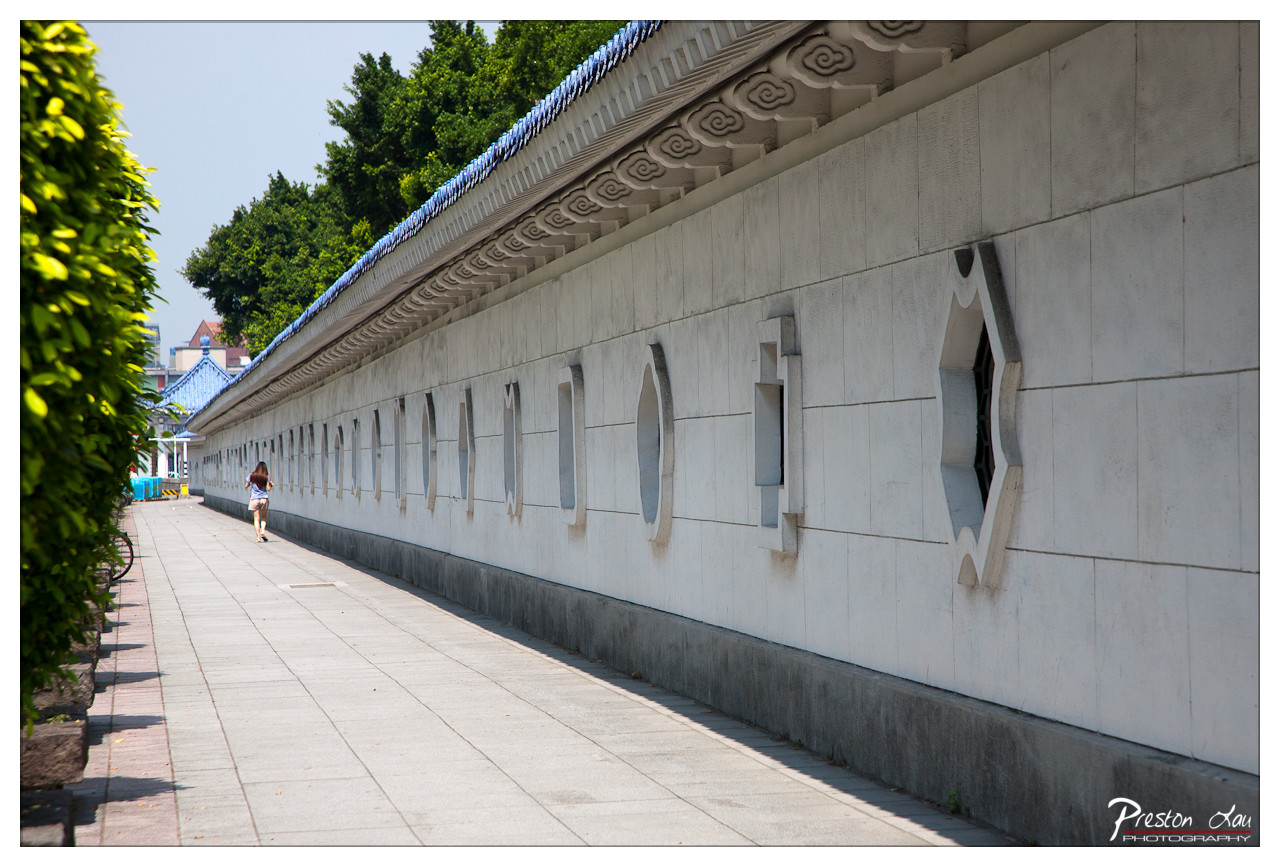

The Great Wall of... Something Zen?
Subject Rating: 7/10 - This wall is definitely the star of the show, a fascinating display of repetitive patterns and unique window shapes, earning it a respectable score for its architectural interest. What's happening is a sole figure, a woman, is walking purposefully away from the camera down a very long, very clean path alongside this striking white wall. The mood feels serene and orderly, almost meditative due to the repeating elements and the sense of perspective drawing you into the distance. It’s a peaceful scene, perhaps captured during a quiet moment of exploration.
From a photography standpoint, this image masterfully uses leading lines – the wall itself and the paving stones of the walkway – to guide your eye deep into the frame. The repeating rhythm of the decorative windows, alternating between circular, hexagonal, and stylized rectangular cutouts, creates a strong visual cadence along the wall. The row of vibrant green hedges on the left provides a lush foreground element and a splash of color that contrasts beautifully with the stark white of the wall and grey pavement. Lighting appears to be mid-day sun, creating relatively flat illumination on the main wall surface but casting defined shadows below the windows and creating contrast. In the background, a building with a distinctive blue tile roof peeks out from behind dense green trees, adding another layer of architectural and natural interest to the scene. It's a clean, architectural study with a human element adding scale and a touch of narrative.
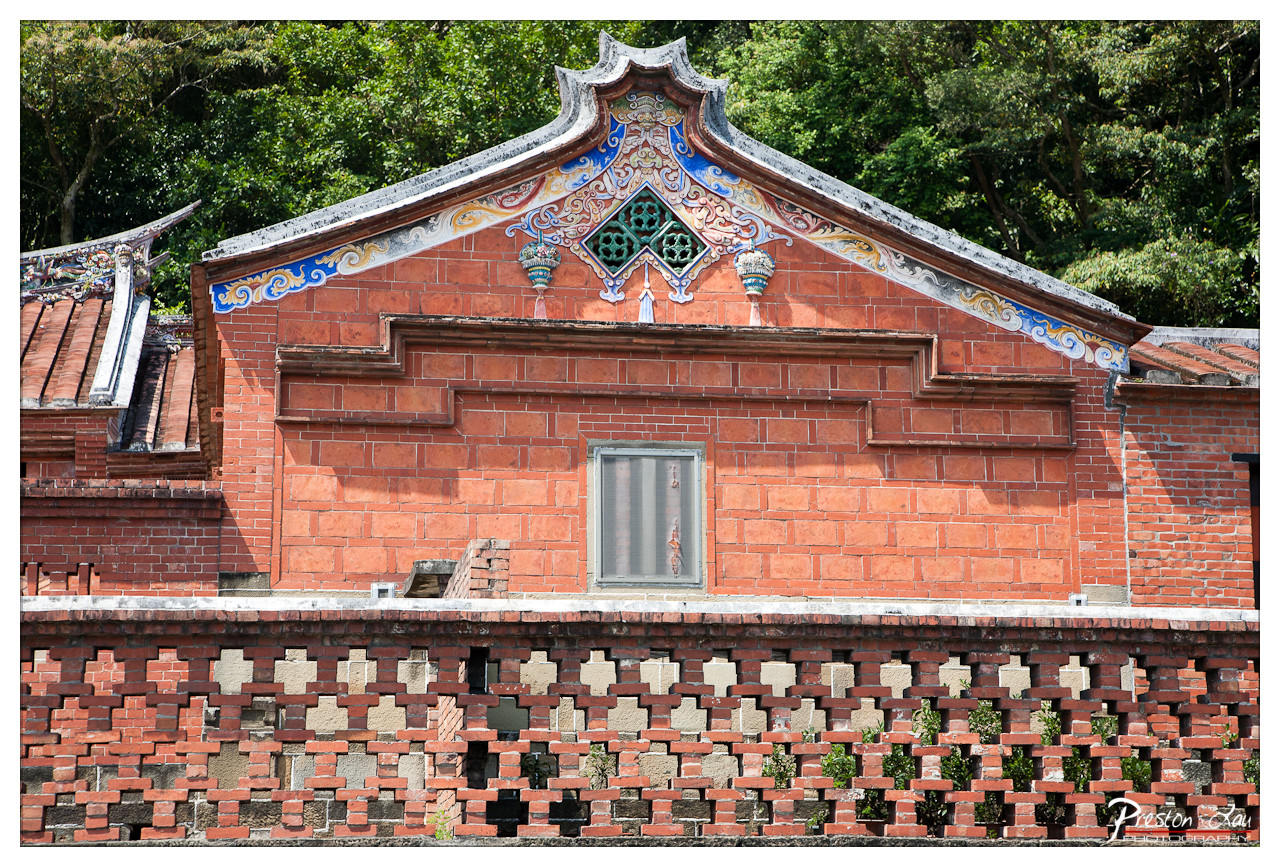

A Study in Traditional Embellishment
Rating: 8/10
This image presents a vibrant close-up of a traditional building's facade, a riot of detailed brickwork and elaborate ornamentation under bright daylight. The subject is the central gable of the building, topped with a distinctive 'swallowtail' roof ridge adorned with colorful ceramic sculptures, including what appear to be fantastical creatures and ornate vases. Below this decorative peak, the wall is constructed from rich red bricks, laid in intricate patterns with recessed and protruding sections that create fascinating shadows and depth. A modest screened window sits below the central decorations, adding a touch of domestic reality to the otherwise fantastical upper section. The lighting is strong and direct, highlighting the textures of the bricks and bringing out the saturated colors of the roof decorations against the deep green backdrop of the trees behind.
The foreground is dominated by an incredibly unique brick fence or wall, a true focal point in itself. This fence features an open lattice-like pattern, combining reddish bricks with lighter stone blocks arranged in a repetitive cross shape, creating a playful, almost optical illusion effect that could be described as architectural tic-tac-toe. Small plants have found homes in some of the openings, adding a touch of unruly nature to the structured design. Compositionally, the fence creates a strong base and an intriguing visual texture that contrasts sharply with the smoother brickwork of the building above. The photographer has chosen a direct, head-on perspective, presenting the building and fence clearly. While the lighting is good for detail, perhaps slightly softer light might have reduced some of the stark shadows, though here they serve to emphasize the architectural relief. Overall, the image is a compelling showcase of traditional building techniques and decorative flair, captured with clarity and an appreciation for intricate detail.
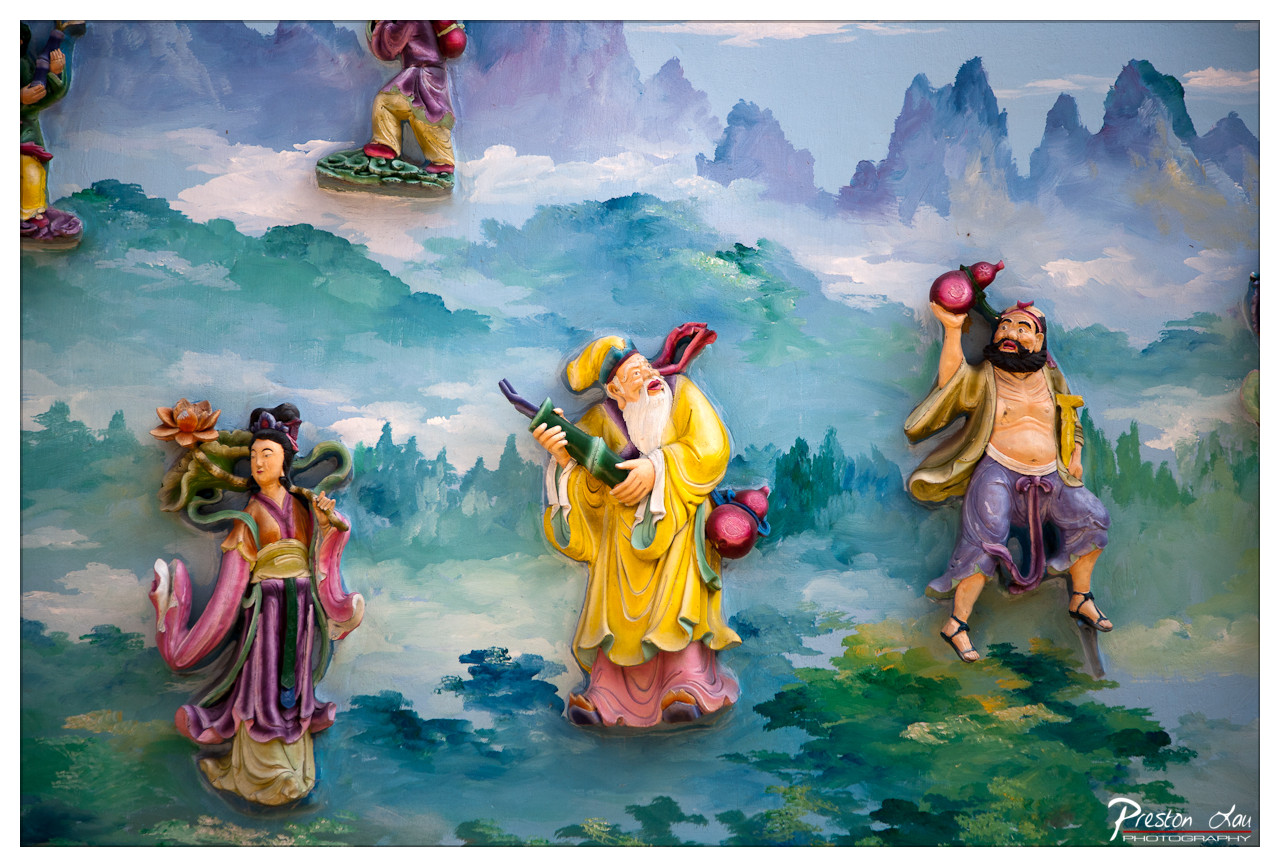

Celestial Gathering
Subject: 7/10
This vibrant image captures a section of a colorful mural adorned with three-dimensional relief figures, likely depicting deities or immortals from East Asian mythology. The scene is set against a painted backdrop of sweeping, misty mountains and clouds, creating an ethereal, almost heavenly realm. At the forefront stands a graceful female figure holding a pink lotus flower, while next to her, a wise-looking elder in a bright yellow robe appears to be playing a flute-like instrument or holding a bottle, a red gourd hanging from his belt. To the right, a muscular, bearded man dynamically holds a large, red double gourd overhead, seemingly celebrating or perhaps preparing to offer it. The overall mood is fantastical and lively, bursting with the rich hues characteristic of traditional religious or folkloric art, populated by these intriguing, larger-than-life characters suspended in their painted paradise.
From a photographic perspective, this image presents an interesting challenge in capturing mixed media. The composition effectively places the three central figures in a gentle diagonal flow, drawing the eye across the scene, although the stark contrast between the 3D figures and the 2D painted background can feel a bit visually jarring. The lighting appears relatively flat, suitable for documentation but lacking dramatic punch, though it does highlight the textures of the sculpted figures reasonably well. The color saturation is incredibly high, reflecting the artwork's inherent vibrancy, which the photographer has captured faithfully – perhaps *too* faithfully for some, making the palette almost overwhelming. As a piece for a photographer's catalog, it demonstrates skill in documenting complex artwork, handling strong, varied colors, and capturing textural differences between sculpted elements and painted surfaces, even if the aesthetic outcome feels less like a curated fine art shot and more like a straightforward record of a wonderfully peculiar mural.
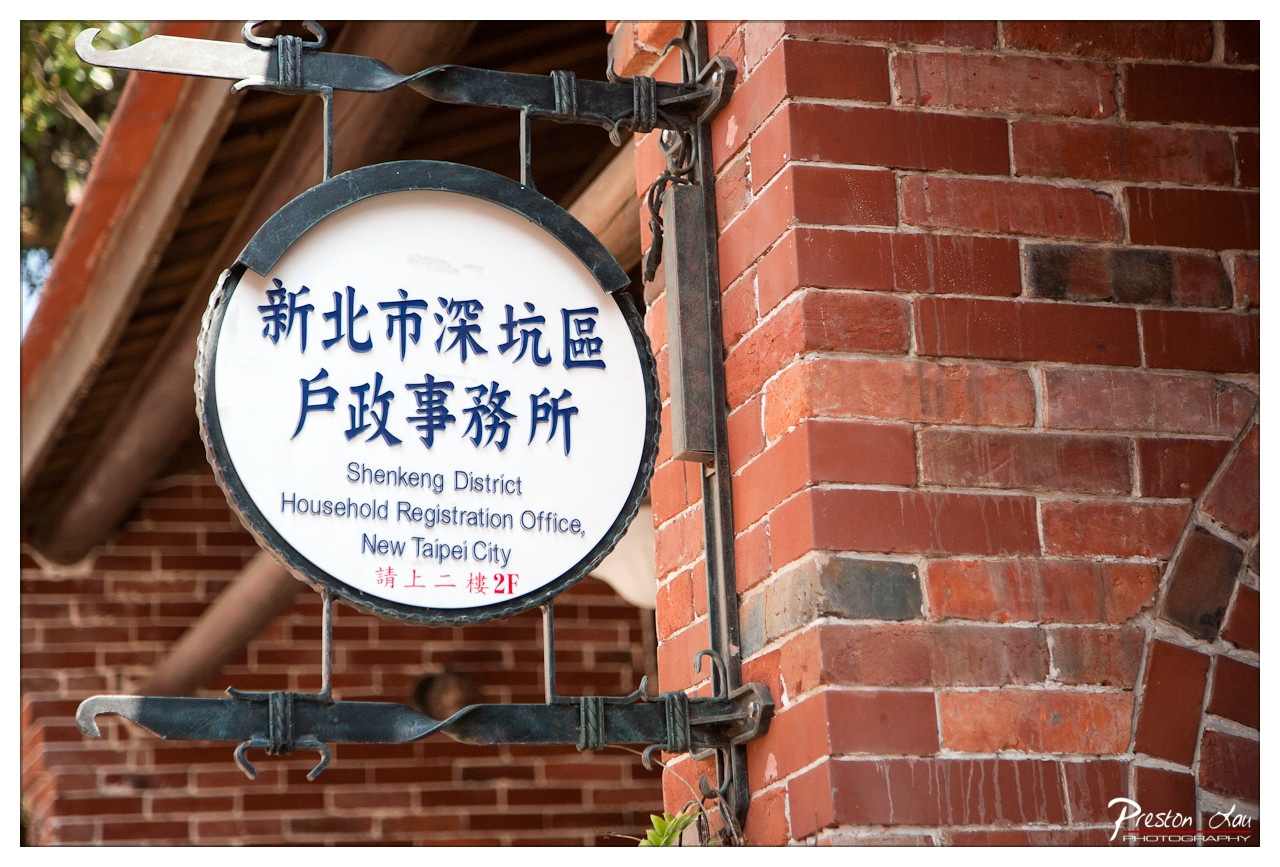

Title: The Bureaucratic Beauty of Shenkeng
Rating: 7/10
Well, who knew a sign for a Household Registration Office could be... a subject? Here we have the official marker for the Shenkeng District office in New Taipei City, letting you know in no uncertain terms (both Chinese and English, plus a handy reminder to trot up to the 2nd floor) where you can go to handle the exciting business of resident registration. The mood is surprisingly serene, despite the implied paperwork hell within, thanks to the warm tones and the rather ornate, if slightly weary-looking, wrought iron bracket holding it up. It's a snapshot of functional architecture, elevated slightly by the details.
From a photographer's eye, this is a solid capture of texture and detail. The focus is sharp on the sign, allowing the vibrant blue text to pop against the white. The depth of field is shallow enough to blur the busy background of roof tiles and distant greenery, but leaves the rich, imperfect texture of the red brick wall satisfyingly visible. Compositionally, the sign is placed to the left, balanced by the large mass of the brick wall on the right, which helps ground the image. The soft lighting avoids harsh shadows, letting the subtle variations in the brick color and mortar work speak for themselves, which is more than you can usually say for government bureaucracy. Good job finding beauty in the mundane!
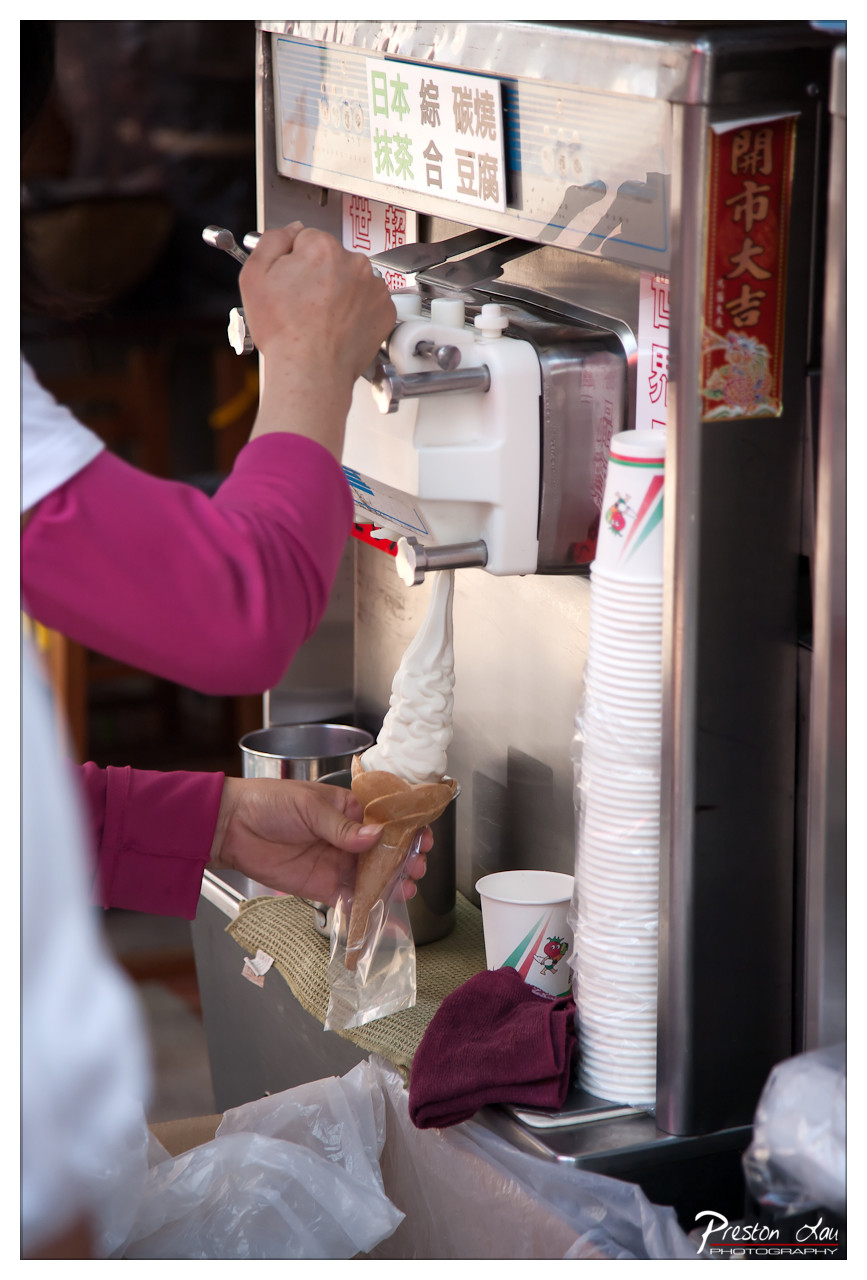

The Swirl of Sweetness
Rating: 7/10
Captured in a moment of delicious creation, this image shows a street vendor expertly dispensing a towering swirl of soft-serve ice cream into a waiting cone. The focus is squarely on the process, highlighting the mesmerizing texture of the frozen treat as it emerges from the gleaming metal machine. The vendor's hands are central to the composition, one operating the lever, the other holding the delicate cone, protected by a plastic sleeve – a practical touch that hints at busy hands and happy customers. The mood is simple and satisfying, evoking the universal pleasure of a cold dessert being made right before your eyes, a small slice of everyday life and a guaranteed mood booster, unless you're lactose intolerant, in which case it's pure agony.
From a technical standpoint, the composition effectively draws the eye to the action, with the hands and ice cream forming a clear focal point. The lighting is soft, perhaps natural or overhead, nicely illuminating the ice cream's structure and the metallic sheen of the machine. The pop of magenta from the vendor's sleeves adds a warm splash of color against the cooler tones of the machine and the white ice cream. While the background is pleasingly blurred, providing separation, details like the stack of cups (sporting an unexpected Italian flag design next to Chinese characters on the machine sign, "日本 碳燒 抹茶 合 豆腐" - Japan Charcoal Roasted Matcha Go Tofu - and a red "開市大吉" - Great Luck for the Opening of Business) add context and visual interest to the bustling scene. It’s a straightforward capture of a delightful subject, perhaps lacking dramatic flair but succeeding in conveying the simple joy of soft serve.
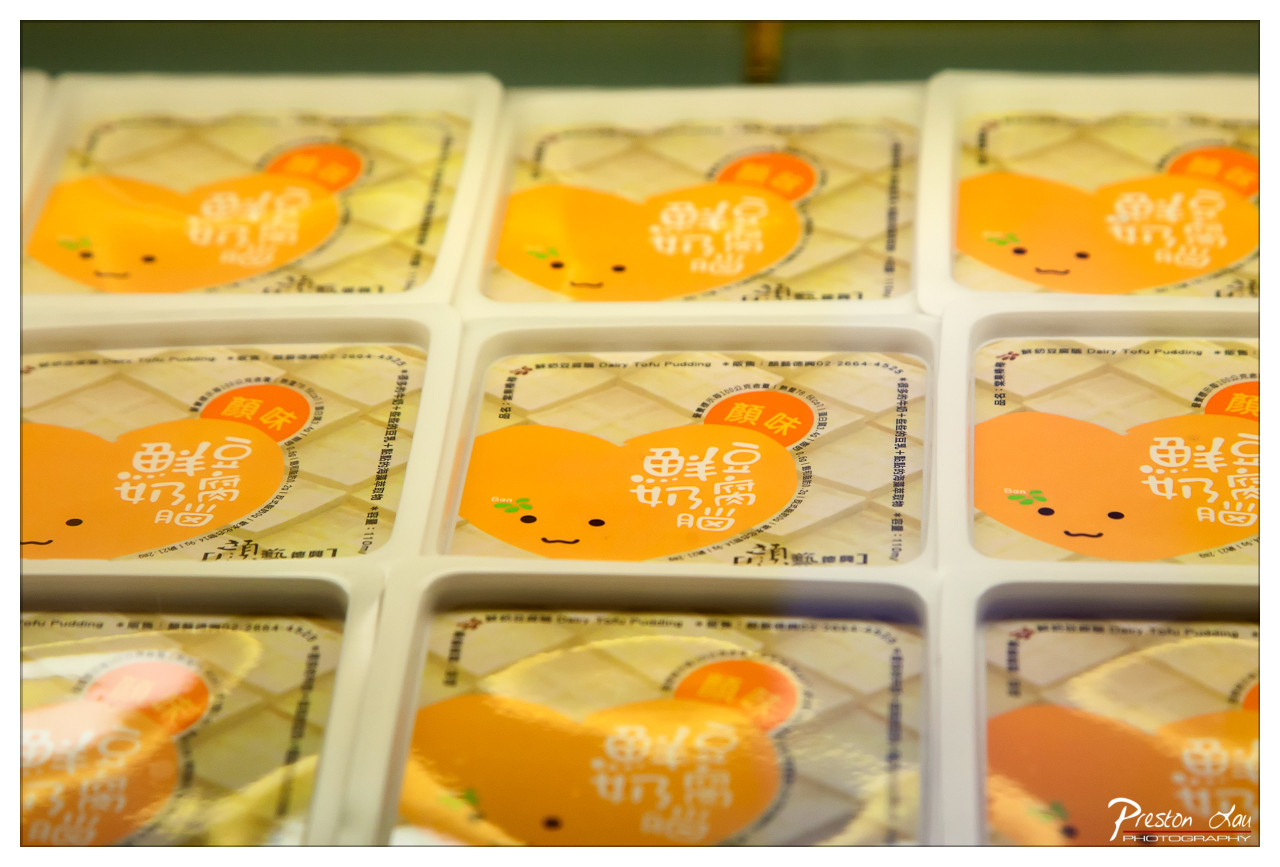

The Great Pudding Lineup
Subject Rating: 7/10
Welcome to the cutest lineup in the dairy aisle! This image presents a delightful grid of individual pudding cups, each proudly displaying an adorable orange heart-shaped label featuring a whimsical cartoon face and some prominent Asian text, presumably the brand and flavor information, along with smaller English text like "Dairy Tofu Pudding." They're neatly tucked into a white, segmented plastic tray, looking rather like tiny, edible characters patiently waiting for their moment in the spotlight. The repetitive arrangement creates a strong visual pattern, emphasizing the product's availability in multiple units, while the slight differences in the cartoon faces add a touch of individual personality to the otherwise identical packages. The background is a pleasant, out-of-focus blur, effectively pushing the patterned puddings to the forefront.
From a photography perspective, the composition relies heavily on the grid, which can sometimes feel sterile but here serves to organize the identical subjects effectively. The photographer has used a relatively shallow depth of field to ensure the front row (and slightly beyond) is sharp, with the rows further back progressively softer, adding a bit of visual depth despite the flat subject matter. The lighting appears soft and diffused, minimizing harsh shadows, which is generally flattering for product photography, although there's a touch of glare on the plastic lids, which is almost unavoidable with this kind of packaging. The color palette is dominated by the vibrant orange of the labels contrasting nicely with the stark white tray, making the product pop. It's a clean, well-lit shot that successfully captures the appealing design of the pudding packages, even if it feels a little like a product catalog shot given the rigid structure.
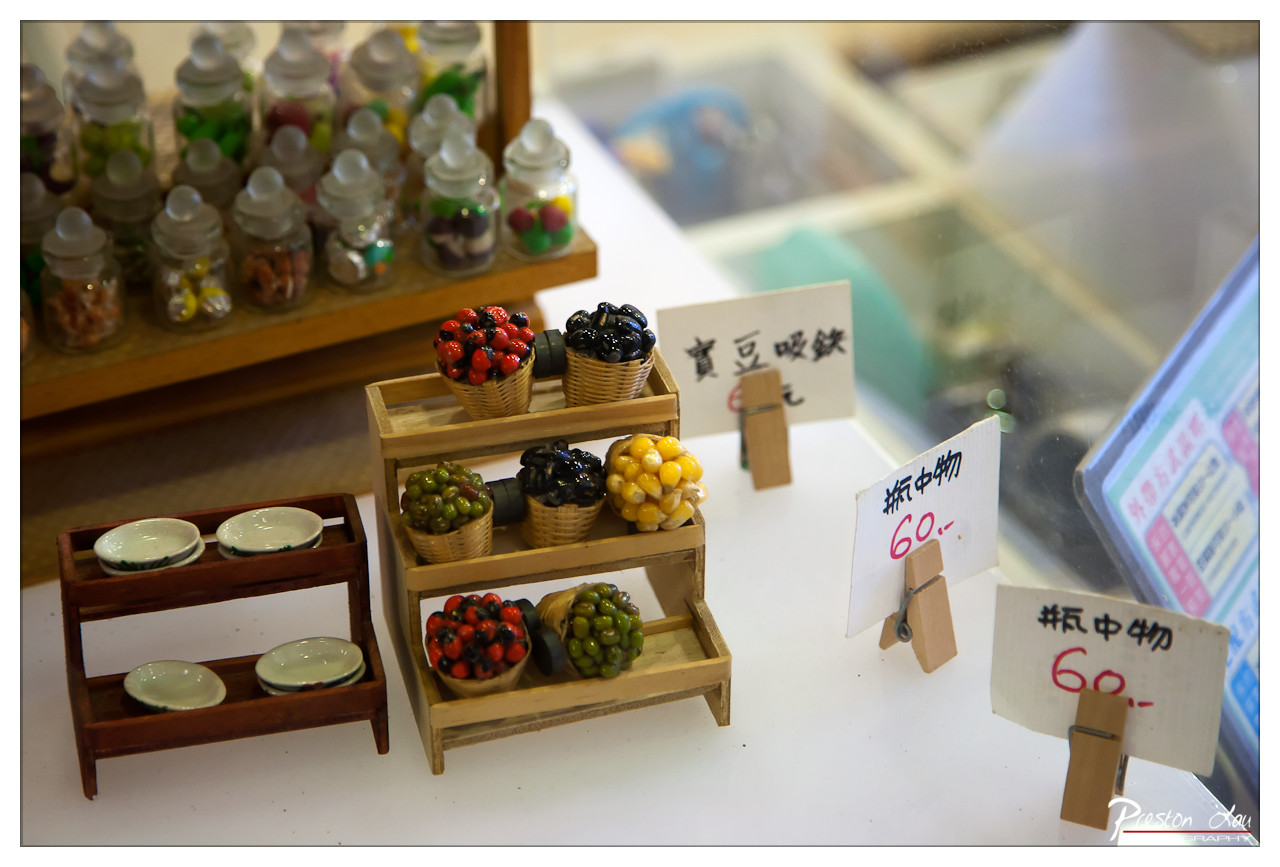

Tiny Treats, Big Detail
Subject Rating: 8/10
Welcome to the land of the tiny! This charming shot plunges us headfirst into a miniature world, specifically what appears to be a very well-stocked dollhouse or diorama shop display. The subject, rated a solid 8, captures the delightful absurdity and intricate detail of these minuscule creations. We see shelves lined with impossibly small jars filled with colourful 'candy' or 'ingredients' in the background, while the foreground showcases even more delightful items: tiny baskets overflowing with 'berries', 'beans', and 'corn', perched on quaint wooden display stands. A miniature two-tiered stand holds equally small ceramic plates, ready for the world's tiniest tasting menu. The mood is one of wonder and playful curiosity, inviting the viewer to lean in and appreciate the painstaking craftsmanship involved. Scattered throughout are miniature price tags, held upright by tiny wooden clothespins, giving a sense of scale and purpose to this Lilliputian emporium.
From a photographic perspective, this image employs a shallow depth of field, likely achieved with a macro lens or similar close-focusing technique, which effectively isolates the detailed miniatures in the foreground from the blurred background. This is a classic technique for drawing attention to small subjects, though perhaps a slightly wider aperture or closer focus point could have rendered the very front objects even sharper, adding a touch more pop. The composition is a bit busy, trying to fit several elements into the frame, but the placement of the display stands and price tags creates distinct points of interest. Lighting appears natural or soft ambient, casting gentle shadows that enhance the textures of the miniature food. The colour palette is warm and inviting, with the vibrant hues of the miniature produce standing out against the wooden stands and white display surface. The background is a pleasant blur of more miniatures and shapes, hinting at a larger scene without distracting from the main subjects – though that blurry blue blob in the distance is a bit of a mystery! Overall, it's a technically sound shot that successfully transports us into this fascinating, tiny retail experience. Just don't try to eat anything; those 60 unit prices are likely for show, and the food definitely is.
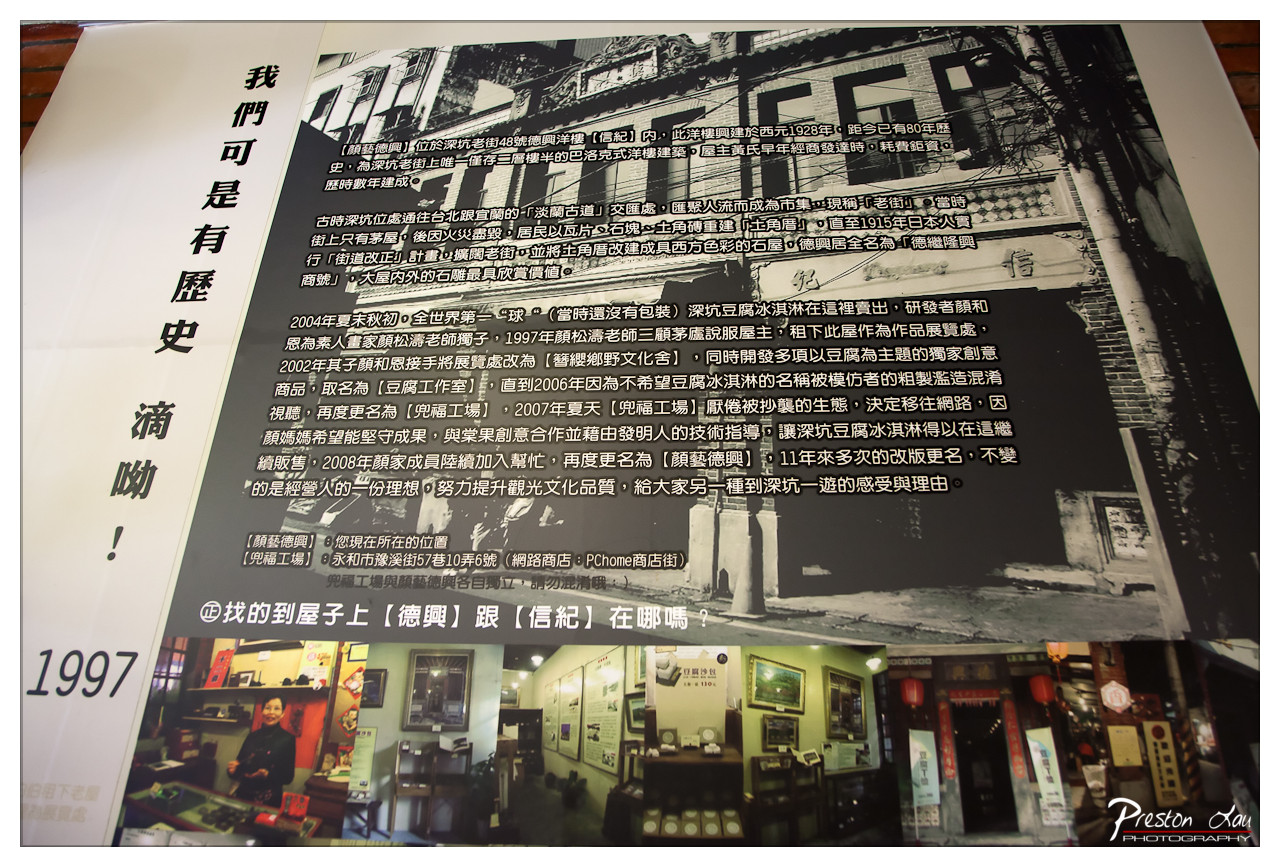

The Historic Panel (Attempted)
6/10
Let's dive into the historical rabbit hole presented here! This photograph captures a fascinating framed display, serving as a window into the past, detailing the history of a building or area, likely in Taiwan given the characters. The text, accompanied by vintage photos and illustrations, promises a rich narrative, rating the subject matter itself a solid 9/10 for historical interest. It's a valiant effort to preserve and showcase local heritage, inviting viewers to connect with bygone eras and the stories embedded in the architecture, like finding specific names ("德興" and "信紀") on the house – a charming interactive element within the display itself. The question posed on the panel "Where can you find [德興] and [信紀] on the house?" adds a playful treasure-hunt feel to the historical account.
However, the photograph itself is a testament to the eternal struggle of documenting framed objects under less-than-ideal conditions. The foreground is a hazy photobomb of blurry textures, distracting from the main event. While the historical panel is the clear subject, reflections on the glass add unwanted sparkle, and the overall lighting appears challenging, possibly contributing to the slight motion blur on the panel itself. The composition places the panel front and center, but the fuzzy elements at the bottom detract. The background, an out-of-focus glimpse into what seems like a cozy, perhaps antique-filled shop interior with shelves, framed pictures, and lamps, adds a layer of context but doesn't fully compensate for the technical hurdles in capturing the primary subject sharply and clearly. A valiant attempt to document some compelling history, but reflections, low light, and blur can make even the most interesting facts look a bit fuzzy around the edges.
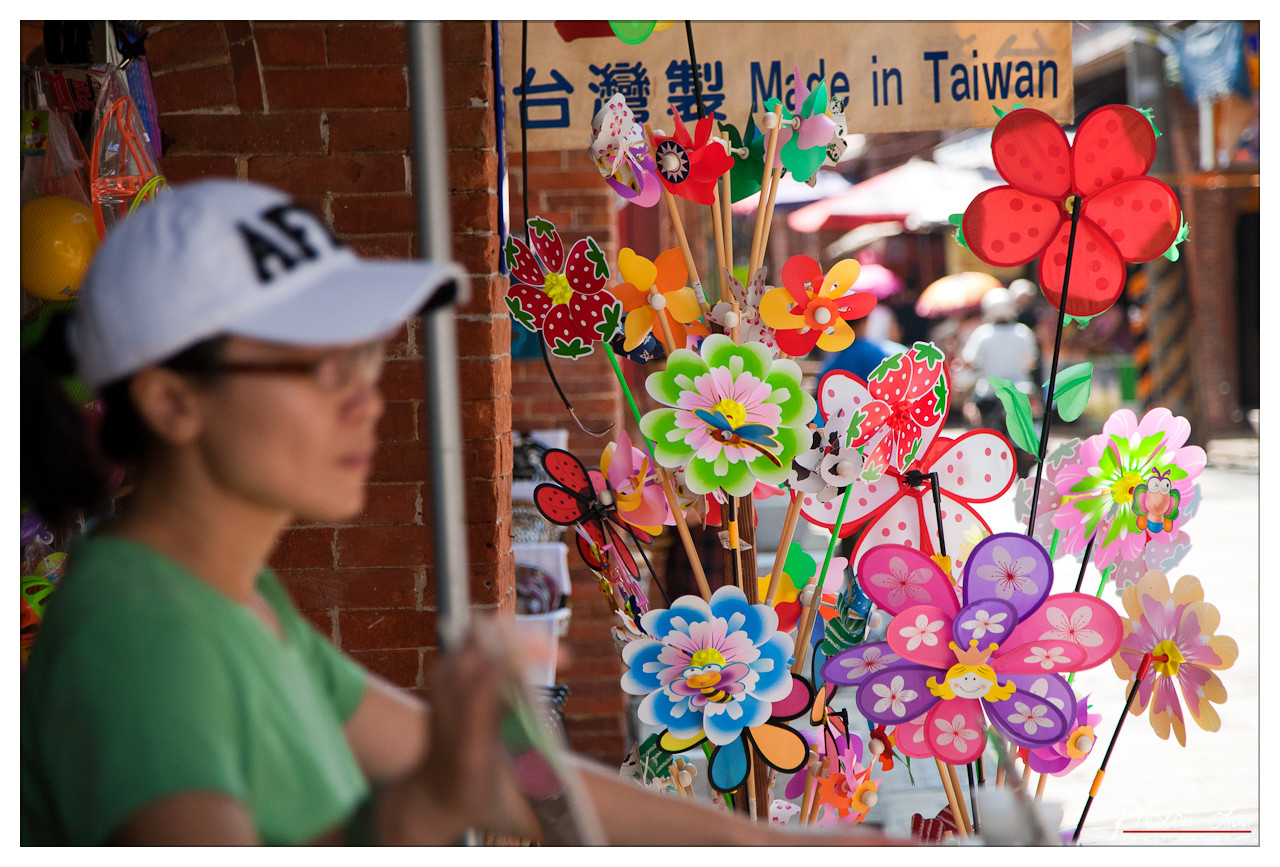

Whirlwind of Colors and the Mysterious Blurry Person
Rating: 7/10
Well, hello there, vibrant pinwheels! It seems the photographer decided you were the real stars of the show, leaving the human subject relegated to a slightly mysterious, out-of-focus blur on the left. Perhaps the dazzling display of flower, strawberry, and butterfly pinwheels, proudly proclaiming "Made in Taiwan" above them, was simply too distracting to allow for anything else to be sharp. What appears to be a market or street vendor's stall is captured here, bursting with cheerful, primary colors that practically hum with energy. The mood is definitely light and summery, evoking childhood joy and perhaps the gentle breeze needed to set these plastic wonders spinning. The blurred person, in a green shirt and white cap, seems to be reaching towards the display, adding a touch of implied interaction, even if we can't quite make out their expression.
From a photography perspective, this image plays with depth of field masterfully, guiding your eye directly to the crisp, colorful pinwheels and the perfectly readable sign. The composition uses the rule of thirds, placing the main visual interest on the right side. The natural light highlights the plastic surfaces, making the colors pop with almost exaggerated saturation – a bold choice that works well for the subject matter. The background is rendered into a soft, pleasant bokeh, offering hints of a busy street scene with blurred figures and umbrellas without drawing focus away from the foreground explosion of color. While some might lament the soft focus on the person, it undeniably amplifies the impact of the pinwheels as the central theme, proving that sometimes, the supporting character is best left in the shadows... or at least, a lovely blur.
Loading map...